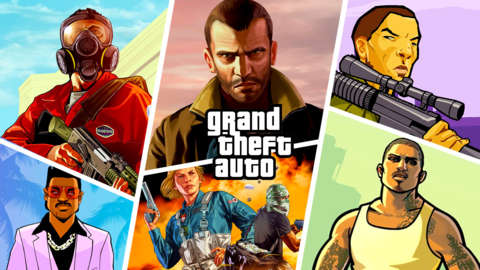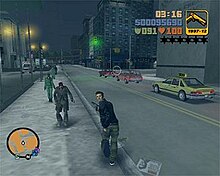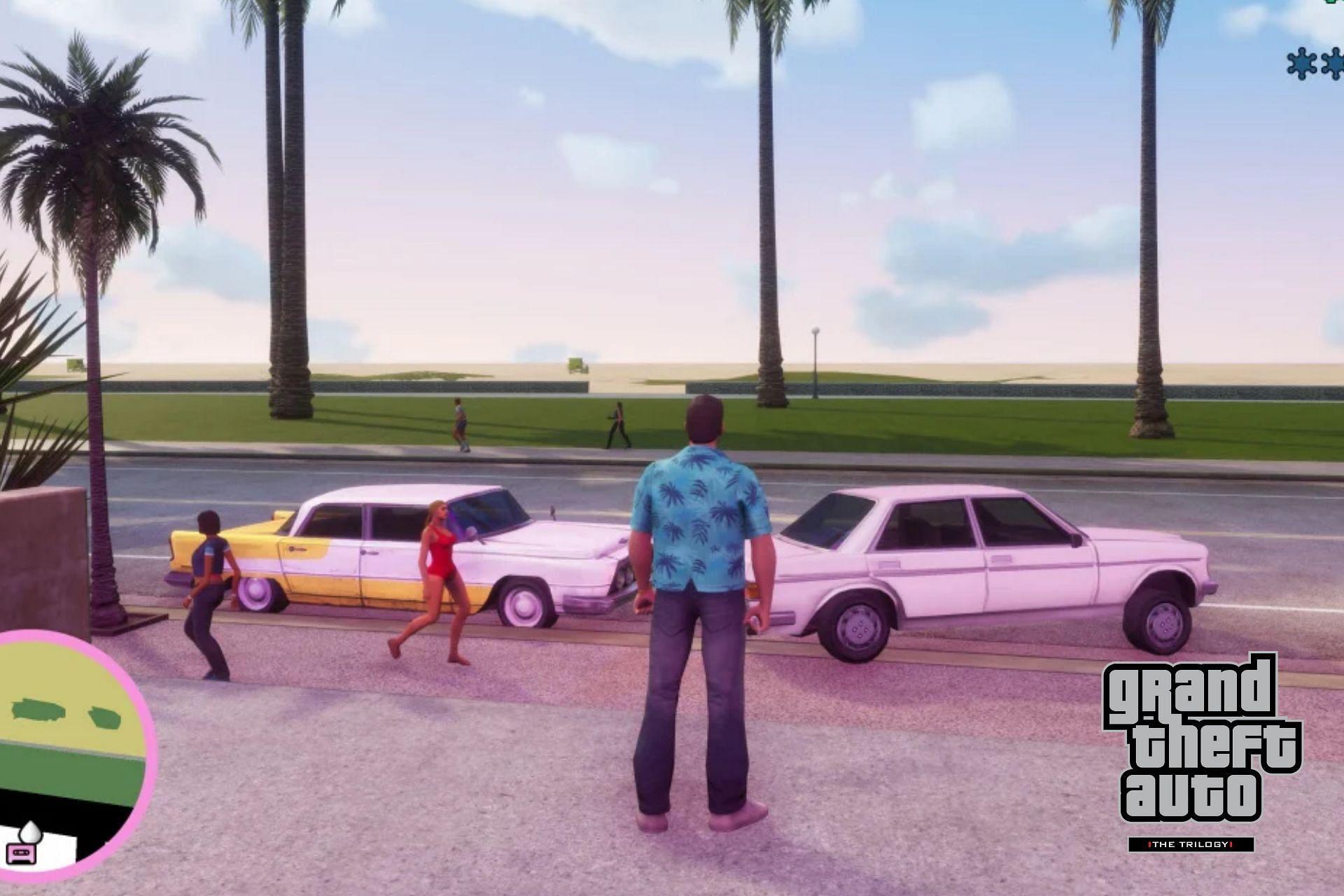 |
IMAGE: GameSpot |
The legacy of GTA games is undeniable. For over two decades, the Grand Theft Auto series has been one of the most influential and controversial franchises in the gaming industry. From its humble beginnings as a top-down crime simulator to its evolution into a sprawling open-world sandbox, GTA has always pushed the boundaries of gameplay, storytelling, and satire.
GTA games are known for their immersive and realistic worlds, filled with diverse and dynamic characters, activities, and missions. Whether it's robbing banks, racing cars, flying planes, or just causing mayhem, GTA games offer endless possibilities for fun and freedom. GTA games are also known for their sharp and witty humor, parodying various aspects of modern society, culture, and politics. GTA games are not afraid to poke fun at themselves, their genre, or their audience.
However, GTA games are not without controversy. GTA games have often been criticized for their violence, sex, and drugs, as well as their depiction of minorities, women, and law enforcement. GTA games have been banned, censored, or sued in several countries, and have sparked debates about the effects of video games on morality and behavior. GTA games have also been accused of glorifying or trivializing crime, corruption, and terrorism.
Despite these controversies, GTA games have been praised for their innovation, creativity, and quality. GTA games have won numerous awards and accolades and have sold over 350 million copies worldwide. GTA games have influenced countless other games and genres, as well as other media forms such as movies, music, and literature. GTA games have also created a loyal and passionate fan base, who eagerly await the next installment of the series.
GTA games are more than just games. They are cultural phenomena that have shaped the history and future of gaming. They are the legacy of GTA.
Grand Theft Auto (1997) and Grand Theft Auto 2 (1999)
 |
| IMAGE: Wikipedia |
In the sprawling digital landscape of video games, there's one title that stands out as a trailblazer, a game that took players on a wild, unapologetic joyride through the gritty streets of virtual cities. Ladies and gentlemen, buckle up as we rev our engines and cruise back to where it all began—the first Grand Theft Auto game.
Released in 1997 by DMA Design, later to become the gaming giant Rockstar North, Grand Theft Auto (GTA) emerged at a time when the gaming world was still finding its footing in the third dimension. This top-down, pixelated masterpiece was a game-changer in more ways than one, introducing players to an open-world environment where chaos and mayhem reigned supreme.
Picture it: the pixelated streets of Liberty City, Vice City, and San Andreas, each waiting to be explored with the reckless abandon of a teenager handed the keys to their first car. The graphics may have aged like a fine wine left out in the sun, but back then, those blocky visuals were the epitome of cutting-edge gaming.
What made GTA so special wasn't just the open-world concept but the sheer freedom it bestowed upon players. Forget the linear narratives of traditional games; here, you were the master of your own destiny, a digital renegade with a penchant for carjacking and a taste for virtual crime sprees.
The radio stations were another stroke of genius. As you careened through the city streets, you could tune into a diverse selection of music and satirical talk shows, providing the perfect soundtrack for your escapades. From funky beats to hilarious banter, the radio stations added an extra layer of immersion to an already immersive experience.
Of course, the missions were the heart and soul of GTA. From simple drug runs to elaborate heists, the game threw you headfirst into a world of criminal intrigue. Sure, the missions were challenging, and the controls could be a bit wonky, but that only added to the charm. It was a game that embraced imperfections, wearing its rough edges like a badge of honor.
Despite—or perhaps because of—its controversy, GTA became a cultural phenomenon, sparking debates about video game violence and capturing the imaginations of gamers worldwide. It wasn't just a game; it was a rebellion, a digital revolution that paved the way for future open-world masterpieces.
As we look back on the first Grand Theft Auto game, it's impossible not to appreciate its impact on the gaming landscape. It wasn't just a game; it was a wild ride, an anarchic adventure that left an indelible mark on the industry. So, here's to the game that started it all—thanks for the memories, the mayhem, and the virtual joyrides that will forever be etched in gaming history.
Grand Theft Auto 2
 |
| IMAGE: Wikipedia |
In the late '90s, the virtual streets of gaming were once again set ablaze with the release of Grand Theft Auto 2 (GTA 2), the rebellious successor to the groundbreaking original. As players eagerly strapped themselves into the driver's seat, they were thrust into a neon-lit dystopia that embraced chaos with open arms.
Released in 1999 by DMA Design (later Rockstar North), GTA 2 took the anarchic spirit of its predecessor and cranked it up to eleven. The top-down perspective remained, but this time, the action unfolded in a sprawling metropolis divided into three districts—Downtown, Residential, and Industrial—each more volatile than the last.
One of the most significant upgrades in GTA 2 was the introduction of gangs. The cityscape was now a battleground for turf wars, and players found themselves playing the role of a wheelman caught in the crossfire. Aligning with one gang meant making enemies with another, adding a strategic layer to the mayhem. It wasn't just about completing missions; it was about surviving the cutthroat urban jungle.
The setting was an eclectic mix of cyberpunk aesthetics and gritty urban decay. The neon signs bathed the streets in a surreal glow, while the dilapidated buildings and grungy alleyways reinforced the sense of a city on the brink of collapse. It was a world where crime paid and rebellion was the only currency that mattered.
GTA 2 didn't just improve on the original's formula; it refined the open-world experience by introducing a dynamic day-night cycle. As the sun dipped below the horizon, the city transformed into an even more dangerous playground, with new missions and challenges arising in the cover of darkness. This added an extra layer of tension, making players weigh the risks of nocturnal escapades.
The radio stations, a staple of the GTA series, continued to shine in GTA 2. From the pulse-pounding beats of Lithium FM to the satirical humor of KGBH, the eclectic mix of tunes and talk shows served as the perfect backdrop to criminal escapades. The soundtrack, like the game itself, became a testament to the era, capturing the essence of a society on the brink of chaos.
While GTA 2 may not have received the same mainstream acclaim as its successors, it was a crucial stepping stone in the evolution of the franchise. It embraced the rebellious spirit of its predecessor while expanding the boundaries of the open-world experience. The neon-lit underbelly of GTA 2 remains a testament to the series' commitment to pushing boundaries and redefining what a video game could be.
As we reflect on the virtual chaos of Grand Theft Auto 2, it's clear that this installment played a vital role in shaping the franchise's identity. It was a wild ride through a city on the edge, a neon-lit rebellion that set the stage for the blockbuster titles that would follow in its tire tracks.
Grand Theft Auto III
 |
| IMAGE: Wikipedia |
In the annals of gaming history, there are milestones that forever alter the landscape, and Grand Theft Auto III (GTA III) stands tall as a true revolutionary force. Released in 2001 by Rockstar Games, this installment not only broke free from the top-down perspective but shattered the boundaries of open-world gaming, leaving an indelible mark on the industry.
GTA III thrust players into the sprawling and crime-ridden Liberty City, a fictional metropolis teeming with possibilities. Unlike its predecessors, the game adopted a third-person, 3D perspective, allowing players to fully immerse themselves in a living, breathing urban jungle. Liberty City became a character in its own right, pulsating with life, crime, and untold opportunities.
The narrative, centered around a silent protagonist known simply as "Claude," was a departure from the linear storytelling of earlier GTA titles. In GTA III, the player had the freedom to shape Claude's destiny through a series of interconnected missions. The plot was a gritty tale of betrayal, revenge, and the cutthroat world of organized crime—a cinematic experience that unfolded in the player's hands.
One of the game's most iconic features was its voice acting. With a cast that included Michael Madsen, Frank Vincent, and Joe Pantoliano, among others, GTA III brought its characters to life with performances that rivaled Hollywood productions. The dialogue was sharp, humorous, and often brutal, adding depth to Liberty City's denizens.
The introduction of a fully voiced radio station, aptly named "Chatterbox FM," marked another milestone. Hosted by the irreverent Lazlow Jones, this satirical talk show became a hallmark of the GTA series, providing a hilarious and insightful commentary on the game's world and pop culture. The diverse radio stations, featuring everything from hip-hop to rock, elevated the immersive experience, making Liberty City feel like a living, breathing entity.
GTA III's impact extended beyond its narrative and voice acting. The game's open-world design offered unprecedented freedom. Players could hijack any vehicle, embark on side missions, and explore the city at their leisure. This freedom paved the way for emergent gameplay, turning each playthrough into a unique, unpredictable experience.
As GTA III celebrated its 20th anniversary, it remained a testament to the transformative power of video games. Its influence is visible in countless open-world titles that followed, and the game's success catapulted the GTA franchise into international stardom. The blend of immersive storytelling, dynamic characters, and unparalleled freedom to wreak havoc in Liberty City solidified GTA III as a pioneer in the gaming industry—a bold step that changed the rules of the game forever.
Grand Theft Auto Vice City
 |
| IMAGE: Sportskeeda |
In the golden age of video games, one title emerged as a glittering gem in the open-world crown—Grand Theft Auto: Vice City. Released in 2002 by Rockstar Games, this installment in the GTA series wasn't just a game; it was a love letter to the '80s, a neon-soaked journey through the sun-soaked streets of Vice City.
Vice City transported players to a fictional Miami-inspired metropolis, complete with pastel-colored skyscrapers, palm trees swaying in the breeze, and a pulsating nightlife that would make even the most seasoned partygoer envious. The city was a character in itself, a vibrant backdrop that oozed the glamour and decadence of the '80s.
At the heart of this digital playground was Tommy Vercetti, voiced by the legendary Ray Liotta. As a character with a penchant for Hawaiian shirts and a ruthless ambition, Vercetti became an instant icon in the gaming world. The narrative unfolded in a world of drug deals, betrayal, and the pursuit of the American Dream, echoing classic crime films of the era.
The soundtrack of Vice City deserves a standing ovation. Rockstar curated an eclectic mix of '80s hits, featuring the likes of Michael Jackson, Tears for Fears, and Hall & Oates. The radio stations, ranging from the laid-back vibes of Wave 103 to the hard-hitting Emotion 98.3, transported players to a bygone era with each tune. The marriage of music and gameplay was nothing short of genius, creating an immersive experience that resonated with players long after they turned off their consoles.
The neon-lit streets of Vice City weren't just for cruising; they were a playground of possibilities. The introduction of properties that players could purchase, like the Ocean View Hotel, added a new layer of depth to the game. It wasn't just about completing missions; it was about building an empire, one shady deal at a time.
The visual style of Vice City was a masterstroke. The vibrant color palette, coupled with the attention to detail in the architecture and fashion, captured the essence of the '80s in a way that felt authentic and nostalgic. From the iconic pastel suits to the neon signs that bathed the city in a warm glow, Vice City was a visual feast that celebrated the era it sought to emulate.
As we look back on Grand Theft Auto: Vice City, it's more than just a game; it's a time capsule of a vibrant and decadent era. It's a celebration of the '80s, wrapped in the chaos and mayhem that defines the GTA series. Vice City remains a testament to the power of nostalgia, reminding us that sometimes the most memorable journeys are the ones we take in a stolen sports car through the neon-lit streets of a virtual paradise.
As we look back on Grand Theft Auto: Vice City, it's more than just a game; it's a time capsule of a vibrant and decadent era. It's a celebration of the '80s, wrapped in the chaos and mayhem that defines the GTA series. Vice City remains a testament to the power of nostalgia, reminding us that sometimes the most memorable journeys are the ones we take in a stolen sports car through the neon-lit streets of a virtual paradise.
As we look back on Grand Theft Auto: Vice City, it's more than just a game; it's a time capsule of a vibrant and decadent era. It's a celebration of the '80s, wrapped in the chaos and mayhem that defines the GTA series. Vice City remains a testament to the power of nostalgia, reminding us that sometimes the most memorable journeys are the ones we take in a stolen sports car through the neon-lit streets of a virtual paradise.
As we look back on Grand Theft Auto: Vice City, it's more than just a game; it's a time capsule of a vibrant and decadent era. It's a celebration of the '80s, wrapped in the chaos and mayhem that defines the GTA series. Vice City remains a testament to the power of nostalgia, reminding us that sometimes the most memorable journeys are the ones we take in a stolen sports car through the neon-lit streets of a virtual paradise.
Grand Theft Auto San Andreas
 |
| IMAGE: IGN |
In 2004, Rockstar Games unleashed a behemoth upon the gaming world that would redefine open-world experiences and leave an indelible mark on the industry. Grand Theft Auto: San Andreas wasn't just a game; it was a sprawling epic set in a fictionalized version of 1990s California, where gang wars, corrupt cops, and the pursuit of the American Dream collided in a digital masterpiece.
The protagonist, Carl "CJ" Johnson, returned to his hometown of Los Santos after the murder of his mother, only to find it torn apart by gang violence. Voiced by the talented Young Maylay, CJ became an instant icon—a character whose journey from the streets of Ganton to the pinnacle of criminal empires resonated with players on a profound level.
One of San Andreas' groundbreaking features was its vast open-world landscape. The game encompassed three cities—Los Santos (inspired by Los Angeles), San Fierro (San Francisco), and Las Venturas (Las Vegas)—each with its own distinct flavor and challenges. The sheer size of the map was staggering, and it was teeming with side missions, secrets, and activities that transformed San Andreas into a virtual playground.
The narrative was an intricate tapestry of loyalty, betrayal, and the struggle for power. As CJ navigated the dangerous waters of gang politics, crooked cops, and shady characters, players were immersed in a gripping tale that unfolded like a crime saga. The inclusion of multiple endings added a layer of choice and consequence rarely seen in gaming at the time.
San Andreas took character customization to a whole new level. CJ's appearance, physical abilities, and even wardrobe were entirely customizable. The game introduced RPG-like elements, allowing players to shape CJ's skills through various activities like working out at the gym or learning to drive. It was a level of detail that enhanced immersion and player agency.
The soundtrack of San Andreas was a cultural phenomenon in itself. With a playlist spanning hip-hop, rock, and funk, the radio stations featured iconic tracks from artists like 2Pac, Guns N' Roses, and Rick James. The eclectic mix not only set the tone for the game but also became a time capsule of '90s music that players could enjoy while cruising the streets in a lowrider.
San Andreas wasn't just a technical marvel; it was a social commentary on the turbulent times it depicted. The game fearlessly explored issues such as race, class, and the crumbling American Dream, adding depth and relevance to its narrative.
As we reflect on Grand Theft Auto: San Andreas, it's clear that the game was a magnum opus, pushing the boundaries of what was possible in the gaming world. Its impact is still felt in the industry today, with its influence evident in subsequent open-world titles. San Andreas remains a testament to Rockstar Games' ability to craft not just a game, but an immersive and unforgettable experience under the Californian sun.
Comments
Post a Comment